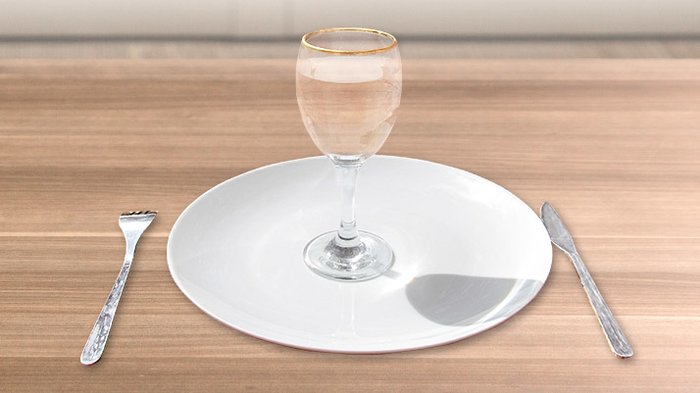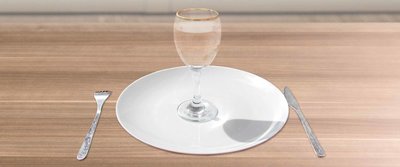If you spend time wandering around fitness and nutrition websites, you've probably heard some mention of intermittent fasting. The first time, you may have laughed to yourself at the concept. I mean, aren't we all intermittently fasting every time there's not actually food in our mouths? Oh, you. You're so clever.
Dig a little deeper, and it's hard not to be a little intrigued by fasting, if only because the people who love it seem to really love it; and people who don't love it often talk about it like it's unimaginable. The pro-fasters say they feel better than they ever have, and point to a wide range of improved health markers. The opponents scoff. The intensity on both sides is enough to make anybody wonder which side they'd take if they gave it a shot.
But where to start? How do the varieties of fasting systems compare? Won't you, like, starve to death?
Broken down to its bare bones, the most basic premise of intermittent fasting is this: sometimes you eat, sometimes you don't. But you spend more time not eating than eating. Really, that's it. That premise alone may have been enough for you to click the little red x and make this article disappear.
If not, then let's dig deeper into the appeal, risks, and different interpretations of the "eating window."
Why is it So Popular?
Perhaps the most important reason behind the increasing popularity of intermittent fasting for both men and women alike is that it's convenient. Think about it: You wake up in the morning and, instead of spending your time in the kitchen, you can make a beeline for the java (or not) and then get straight to work.
There's no food prep, no cleanup, and nothing getting in your way of your productivity. Additionally, many people report (and I personally have found) that being in the fasted state puts them on a high of sorts. They say they feel more energized, more alert, and consequently more able to accomplish things.

Who is fasting for?
You might like intermittent fasting if you fall into one or more of the following categories:
- You're very, very busy in your day-to-day life.
- You work a job that makes frequent eating a huge hassle.
- You're a lazy cook.
- You have a big, big appetite.
- You hate Tupperware and can't find half your damn lids.
- Most important, you've experimented with it in a rational way and had positive results.
Raise your hand if you're a snacker in the p.m. Should be most of you. Now keep your hand up if you frequently find yourself hovering around the kitchen in the evenings, opening and shutting the food cabinets, somehow expecting different snacks to magically appear before your eyes.
Pushing back your feeding window means you can afford to eat more in the evening, when willpower dips to its lowest. Why is this great? It takes a normal weakness and turns it into a huge strength. Really, during your moments of vulnerability, does it make sense to deprive yourself of the things you want? It doesn't have to be that way.
Some people crave simple satiety through treats or wholesome foods. Others yearn specifically for carbohydrates and gravitate toward rice, sweet potatoes, bread, and the like. Still others (such as myself) reach for the gummy bears and desire nothing more than to snuggle up in bed with a bowl of butter pecan ice cream before drifting off.
Intermittent fasting offers you the freedom to deal with your cravings in a finite space, rather than battling them over and over through the day and subsequently amplifying them. Many people find they can still eat what they want, within reason, and stay trim. Under pretty much all systems, you can fall asleep with a full stomach and a shit-eating grin plastered on your face, and you can still nail your macros for the day.
That means you can shed fat without feeling like you're dieting. In general, you will face a whole lot less resistance with your food choices in your day-to-day life.
How Do I Know Which System is for Me?
At first glance, you don't. At second glance, you'll realize that one appeals to you a bit more than the others and that you have some reading to do.
I know, you want me to tell you exactly what to do. You want the answers, and of course, the Big Man behind each method will tell you that his way of eating is the best way. But coming from a financially unbiased stance, I can tell you that different approaches will work best for different people. The trick is to find the best one for you.
Here's the CliffsNotes version of five of the most popular current intermittent fasting methods. These are rudimentary summaries, so I encourage you to click around and do your research to learn more about each approach. Each of them also has a different notion of how you should recalibrate or behave during a "break-in" period, so keep that in mind when you research further.

Lean Gains by Martin Berkhan
- Involves an 16/8 protocol (meaning fast for 16 hours of the day, eat for 8).
- Macronutrients and overall calories are cycled throughout the week: more carbs and calories on training days, more fats on rest days.
- Cheesecake and other yummy goods encouraged several times per week in specific windows.
Eat Stop Eat by Brad Pilon
- Fast for 24 hours once each week; eat regularly the rest of the week.
- Freedom to eat how and what you want on your feeding days.
Renegade Diet by Jason Ferruggia
- 16/8 feeding cycle (14/10 for women) with the majority of carbohydrates falling in the evening.
- Very health-focused: organic, whole foods; though the approved food list is fairly short.
The following two diets are often grouped with intermittent fasting diets, but they can allow for a limited amount of food consumption during the day. As such, you may not spend your day in a "fasted" state, which is generally considered to begin 8-12 hours after your previous meal (hence the word "breakfast").
The Warrior Diet by Ori Hofmekler
- 20/4 daily feeding cycle: undereat during the daytime, overeat at night.
- Undereating window can include limited amounts of raw fruits and veggies, poached eggs, yogurt, coffee, and tea.
- Encourages eating ad libitum from all food groups during the feeding window until full.
Carb Backloading by John Kiefer
- On Kiefer's 18/6 protocol, you consume protein and fats throughout the day, saving most carbs and calories for the evening after training.
- Encourages consumption of high glycemic index foods in the post-workout meal, including cherry turnovers, donuts, and pizza.
What to Watch Out For
You may look at the above list and feel like one of them has to work for you, but it's possible that none will. Although many of my clients and I have had great experiences with different variations of fasting, I feel obligated to inform you that it is not for everyone.
First and foremost: Fasting isn't just an excuse not to eat. I know women who have reported that the discovery of intermittent fasting has essentially eliminated much of their chronically disordered eating behavior, while others have experienced the opposite, with increased episodes of binge eating, anxiety, and neurosis surrounding food.

"Intermittent fasting offers you the freedom to deal with your cravings in a finite space, rather than battling them over and over through the day."
On a purely physical level, some of you may just feel like crap, unable to last through the morning hours without doubling over from the sharp pangs of hunger. Others will feel groggy, lethargic, and drained of energy with intermittent fasting. Some will find a way to abuse the rules of intermittent fasting. You may find yourself trying to justify your continued junk food-dominated diet because you've crammed it to an 8-hour window, as if that somehow makes trash more OK to consume (it doesn't). Maybe you'll become more obsessed with food: looking at the clock more often, counting down the seconds until you can break your fast.
If any of the above ends up being the case, then don't try to force yourself into something that doesn't fit. There's nothing wrong with eating smaller, frequent meals spread over the course of the day if that's what works better for you. Neither method is necessarily wrong. What is wrong is either being a slave to your diet, or being totally out of control.
Ready? Not So Fast…
Rather than diving headfirst into pure intermittent fasting, I strongly recommend a 2-3 week acclimation period before embarking on any particular system. It's not uncommon to experience some pretty uncomfortable bouts of hunger during the initial stages, so I think it's a good idea to slowly shave down the feeding window rather than jumping from 14 to 8 hours.
So maybe the first week, try cutting your feeding hours from, say, 6 a.m.-8 p.m. to 8 a.m.-8 p.m. That's a 12-hour window you're working with. That seems doable, right? Hunger pangs will be nonexistent at best, mild at worst.
With regard to food choices, eat the same things you've been eating, or depending on which form of intermittent fasting you elect to try, slowly start eliminating certain foods from your diet and replacing them with others. Maybe cut out those breakfast Pop-Tarts, or at least save them for your post-workout meal. You could swap out coconut oil in the place of butter or shortening when you cook. Or you could just add more fish, or fish oil, into your diet.
During week two, you'll take it a step further and eat only from 10 a.m-8 p.m. Think of it simply as a mid-morning breakfast. And dinner is still dinner.
Week three is the final phase of your acclimation period, where you'll have your first 8-hour feeding window. Congratulations, you've just lost your IF-irginity! Cheers all around, and protein drinks on me!
By the end of those three weeks, there's a good chance you'll know whether intermittent fasting (or at least the approach you've chosen to test out) is a good fit for you. There's no better teacher than experience, right?
I know some of you reading this are impatient and eager to plunge into this. You think you're too hardcore to need any sissy acclimation period. If that's the case, then sure, go ahead and jump straight to the 8-hour window. Don't say I didn't warn you, though.
FAQs On Fasting
I'm a shift worker. Can I still practice intermittent fasting?
Technically you can, but if your feeding window changes all the time, it can wreak havoc on your metabolism. It's far from ideal. Work with what you've got, but do your best to eat at approximately the same times every day.
Do I have to count macros while intermittent fasting?
No, you don't. But understand that just because your feeding hours have been reduced doesn't mean that your diet has now become a free-for-all. You will still gain weight if you consistently eat over your maintenance calories, no matter how narrow your feeding window is. Intermittent fasting is pretty neat, but it isn't magic.
What if I miss my window? For example, if my typical feeding times are from 10 a.m.-8 p.m. but one night I don't eat until 10 p.m. Do I adjust my feeding window the next day?
There will invariably be days when this happens, because life gets in the way. The train came late, you were wrestling with your baby, or you flat-out forgot. It happens. Just eat when you can and go back to your normal hours the next day. Don't sweat it. Again, try to be as consistent as possible.
How will intermittent fasting affect my workouts?
You don't necessarily have to change the way you train just because you're intermittent fasting now. Some methods will call for specific ways of training, and if that's the case, then follow the appropriate protocol. Otherwise, keep doing what you're doing in the gym.
What do I do if I train at the butt-crack of dawn?
If you train early in the morning or at any point before your feeding window, then it might be a good idea to sip on some branched-chain amino acids (BCAAs) to keep from feeling depleted while training. Different protocols have different views on this and other supplements, but I've personally found aminos to be helpful. You can then break your fast immediately afterward, or continue the fast with more BCAAs until it's time to chow down.
What would a typical day look like if I trained in the morning?
There are many ways to go about this. But here's just one example, again using BCAAs:
- 6 a.m.: 10 g BCAAs with water
- 6:30 a.m.-7:30 a.m.: Training + 10 g BCAAs with water
- 8:00 a.m.: 10 g BCAAs with water
- 10 a.m.: Meal 1
- 2 p.m.: Meal 2
- 6 p.m.: Meal 3
The timing and macronutrient composition of each meal will inevitably differ based on whichever intermittent fasting protocol you're adhering to, but in general, this works out well for me.
If we're talking about cardio, you probably don't need aminos unless it's going to be high-intensity in nature.
Will my strength plummet?
Actually, plenty of people report that they experience increased performance in the gym. Pretty cool, huh?
I've been doing intermittent fasting and I feel sooo horrible. What can I do?
The whole premise of eating a certain way should be that it makes your diet easier, not harder. If you're really having that bad of a time, don't do it. Plain and simple.

